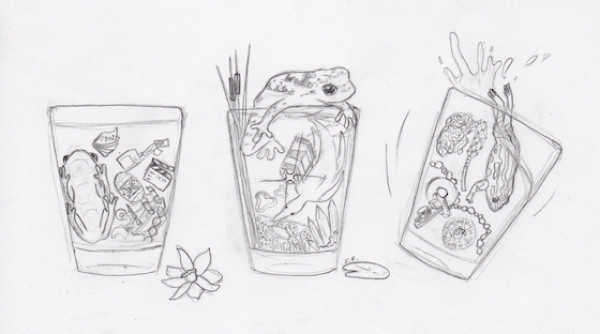© Pint of Science, 2025. All rights reserved.
Jump In!
Dr Emma Rehn

Artist biography
Dr Emma Rehn is our Artist in Residence for the 2022 Pint of Science AU Festival! After completing her PhD palaeofire (studying ancient bushfires), she is now a postdoctoral researcher in archaeology at James Cook University, with the ARC Centre of Excellence for Biodiversity and Heritage.
Her creative flair and fascinating knowledge of ecology are combined in this detailed artwork titled 'Jump in!', which honours Australian flora and fauna along with other scientific endeavours within the microcosm of a Pint glass.

Support The Artists
Find out more about Emma’s research here, or follow her on Twitter and Instagram.
Artist rationale
The Australian animals at the forefront of climate change risk are our native frogs. Frogs are indicator species for water quality and wetland health, as they absorb chemicals from air and water through their skin, and they are threatened by a deadly combination of chytrid fungus and climate change.
This work symbolises what we know, what is still left to discover, and what we can act now to save, represented by three frogs:
The mascot of this piece is Misty the armoured mist frog [centre pint glass]. Like myself, she’s a local of the Wet Tropics of Queensland. Little research has been done on the armoured mist frog; we don’t even know the sound of its call. They are critically endangered and were thought to be extinct until a small population was rediscovered in 2008. Misty’s close relative the mountain mist frog is likely already extinct, but it’s not too late to save the armoured mist frog.
We know more about the Kuranda tree frog [left pint glass], another Wet Tropics local. Unlike most of Australia’s endangered frogs, the Kuranda tree frog’s biggest threat is habitat loss from development. There are an estimated 700 individuals remaining.
Substantial research has been done and is ongoing on the southern corroboree frog [right pint glass], found in southeast New South Wales. Current conservation programs include captive breeding in NSW, ACT and VIC. Multiple research projects are investigating the genetics and life cycle of southern corroboree frogs, and even developing ways to increase their fertility.
These frogs also symbolise jumping into science, encouraging everyone to participate and get involved with changing our world for the better. The six themes are represented by historical and recent discoveries and innovations in Australian science grouped into three pint glasses (left pint glass: Our Body & Our Society, centre pint glass: Atoms to Galaxies & Planet Earth, right pint glass: Beautiful Mind & Tech Me Out).
A few objects in this preliminary sketch include – Left pint glass: AIATSIS dictionary project, cochlear implant, inventions of the notepad (1902) and clapperboard (1930), HMS Pandora (Queensland Museum), and OpenAPS (Artificial Pancreas System; Australian Centre for Behavioural Research in Diabetes). Centre pint glass: CUAVA-1 satellite, Richmond pliosaur, and Living Seawalls (Sydney Institute of Marine Science). Right pint glass: Black Box (1958), orbital engine (1972), intertidal fish traps (Kaiadilt and other Indigenous Australian groups), the Sydney Brain Bank (NeuRA), mobile stroke unit (Stroke Foundation), and Stentrode (Synchron and the University of Melbourne).
